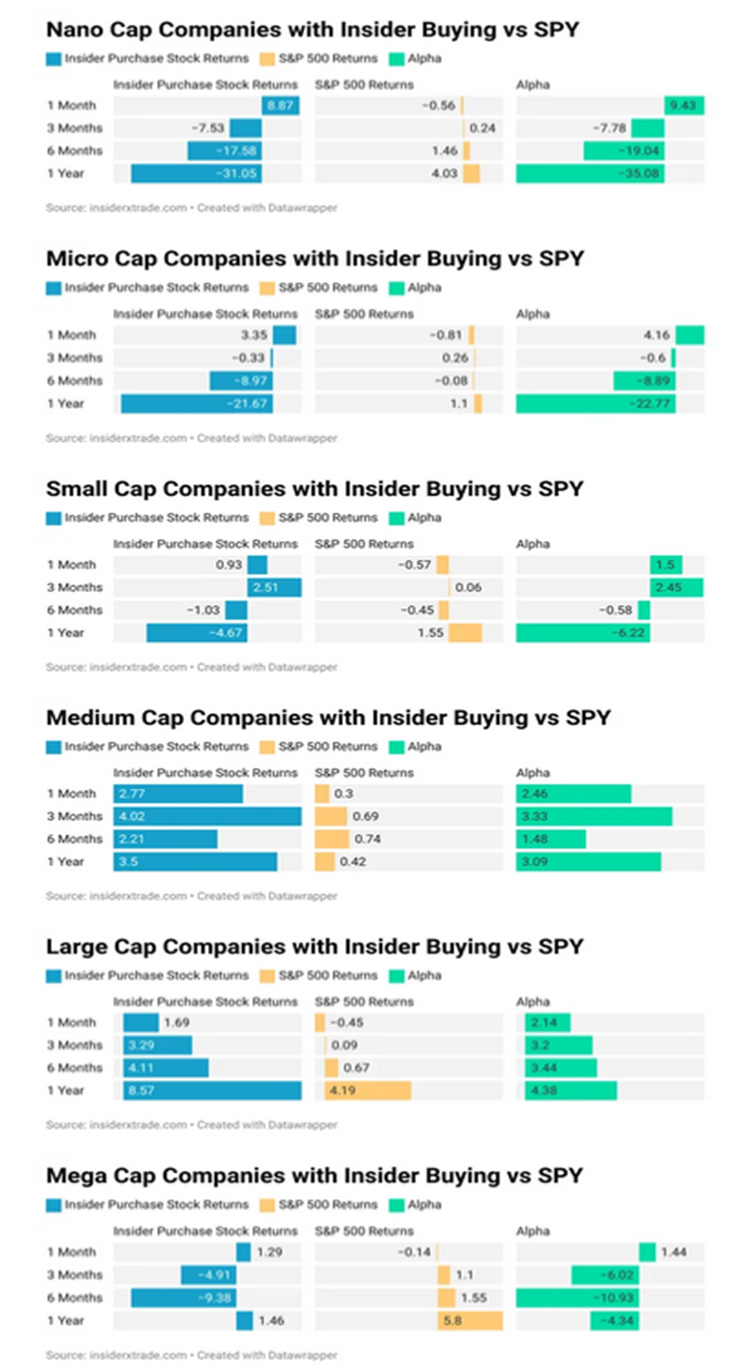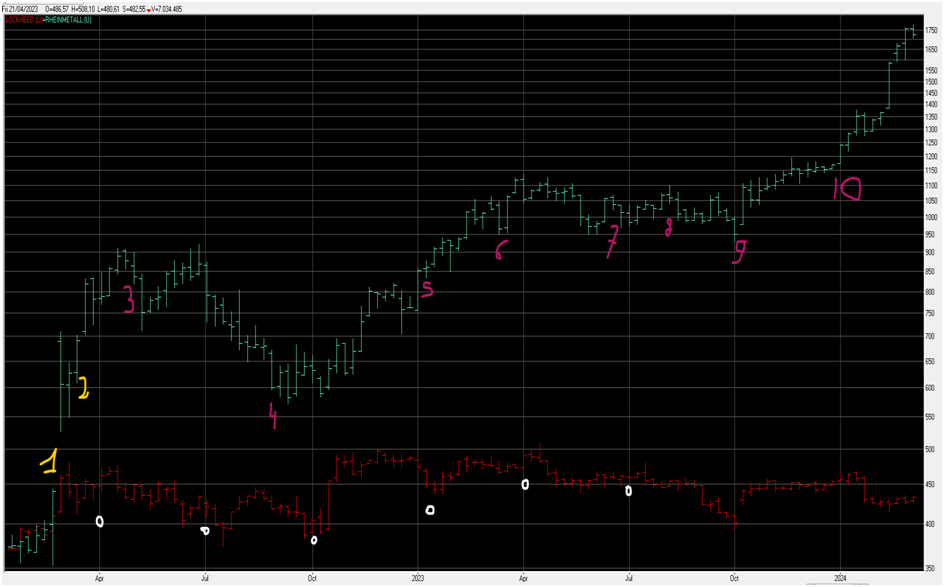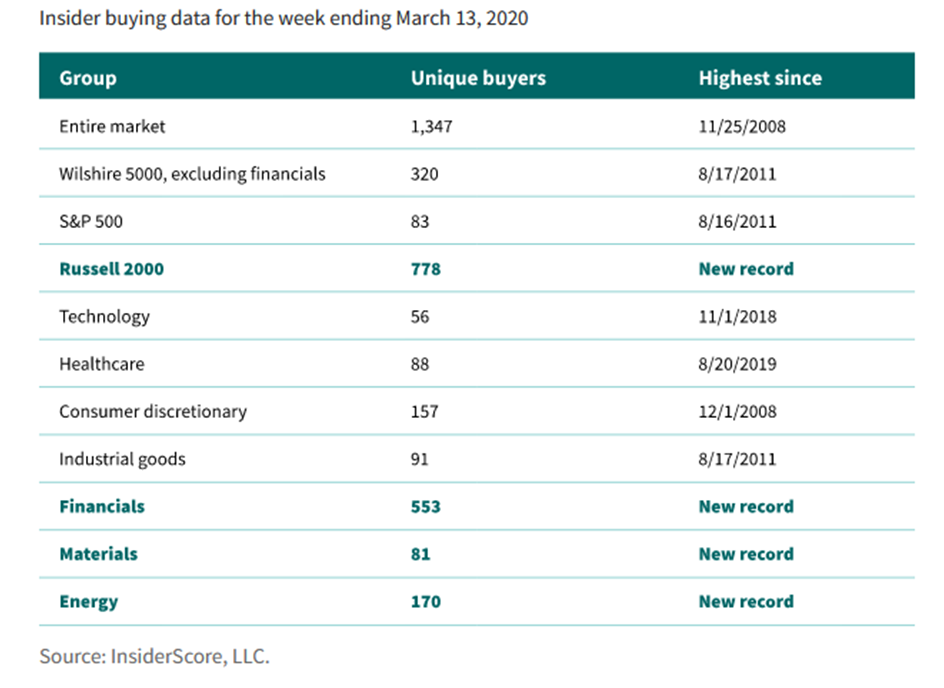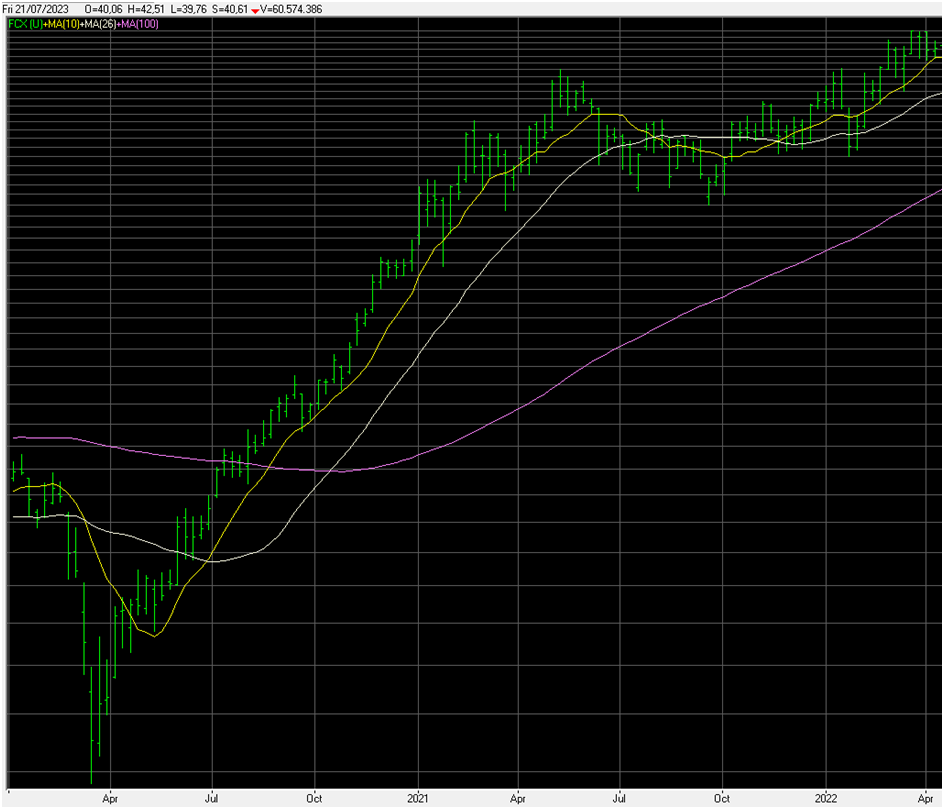
Insider Buying and Selling
In doing so we are competing with quant-based analysis that is poring hundreds of millions of dollars into similar things and rarely does the retail investor get a peek in with any edge. Courtesy of regulation, however, there are a number of things that we – the retail investor – can see as well (or as poorly) as anyone else and one of those things is insider buying. Due to grey zones in reporting and execution of trades, the exact timing is not what matters the most, it is simply a head’s up that insiders are buying.
Why is this meaningful, well to quote one of the old-time investment greats:
“Insiders might sell their shares for any number of reasons, but they buy them for only one: they think the price will rise.” —Peter Lynch
Insider buying is much more significant than selling because so many reasons can cause a person to require money that have nothing to do with the company in question, the most obviously ubiquitous one being DIVORCE! Buying is extraordinary because those doing it are actually increasing their exposure to the stock in question when usually they are already employed by the company and on top of that tend to benefit from share options or company plans. Occasionally a CEO/CFO has to make a public show of confidence in his own company by buying (avoid those situations) but by and large the run of the mill insider buyer really has no reason to buy except they think things are looking good for the stock. In betting terms, insiders buying is them doubling down on an already very large exposure to the success of the company in question.
Peter Lynch was very much a person who believed you should invest in stocks you understand. The example he gave of ‘unexpected’ insider buying (i.e. an unregulated one) was the 1950s fireman assuring fire safety rounds in an industrial area around Palmer Massachusetts who had to keep widening the walk of his round due to a particular company (Tambrands) expanding all the time. Without really knowing what they made, he bought shares in the company in question and retired a millionaire by 1970. In the same logic I invested (for my mother’s portfolio) in NVDIA back in April 2016 – why? My company pitched for their business (we didn’t get it) and their public RFP was the first document I ever read that made any sense to me as regards a strategy for AI (self-driving cars in fact). These two examples do have a warning inherent in them and Peter Lynch’s quote above is frequently cited but his second recommendation is more rarely reported:
“Finding the promising company is only the first step. The next step is doing the research.” —Peter Lynch
NVDA case
The NVDIA situation was a case in point, the investment made for my mother was based on her having a diversified portfolio and an understanding of semi-conductor stocks. A nice RFP itself wasn’t the only reason to choose to take the plunge, it was combined with other considerations and this is how you should approach all insider buying. There was a very interesting Reddit post about this which we shall shamelessly steal from use as research in this article. You see, not all insider buying always leads to success.

Figure 1 Source r/options on Reddit 02/25/2024
The above research by the redditor covered a 3-year period and provides sobering reading for anyone believing it is simply a question of blindly following insiders. Whilst the post was probably meant to get you to subscribe to insiderxtrade.com, it was quite enlightening. The period covers 3 years prior to Q2 2023 which was a particularly challenging stock market environment. One might conclude that the smallest cap stocks are only interesting in the shorter time frames and possibly that mid and larger cap stocks insider buyers are more on point about what they do. This analysis followed an older analysis that was less granular but likewise concluded that simply trading the S&P yielded more positive returns BUT insofar as the returns of the insider buyer were winners, they were larger winners than the S&P by some margin. So clearly whatever we do it cannot simply be to buy when insiders are buying.
Whom should you follow?
This brings us back to the same question: we should only follow the right insiders but the question is which ones?
The answer is that we should follow those where other things tell us that the stock in question could be of interest but that we are unsure about the general timing of entering an uptrend. Warren Buffet’s idea that what went up last year will go up next year is a truism that is hard to follow in practice when we inevitably pick the one stock that nosedives despite a stellar prior year. An example of a reasoned approach using insider buying is given below for two companies in the defense sector. In RED is Lockheed Martin (LMT) and in BLUE is German stock market quoted defense firm Rheinmetall (RHM.DE).
To understand the chart below, note that for both companies – as is usual for any quoted companies – they are subject to certain quarterly windows of buying and selling which are easily identifiable looking at the timing of purchases by insider.

-
Points 1 & 2 in yellow are public events relevant to the two stocks in question – namely Russia’s invasion of Ukraine and the announcement by the German Chancellor of a “Zeitenwende” a fancy German term that Bob Dylan stated more simply as: “The times they are a changing”. This coincided with a €100 billion defense spending package to upgrade the German armed forces. No prizes for guessing that both items are relevant for a defense stock but where the first event drove both of them; the second only drove up the German firm. Whilst US companies in defense make more money – the few remaining in Europe stand to grow faster as they start from a much lower base. This made them interesting to invest in.
-
The little white dots is the insider buying in LMT – in fact it is one man: John Donovan who hasn’t had the best of luck in his choices to get in. This from amongst the 115,000 employees of LMT and a very large corps of people that must report insider trades. LMT reports about 30 insider trades a year – mainly executions and sales. John is the lone bull and combines his LMT director position with a director position at PANW;
- The reddish pink numbers are buys by Rheinmetall insiders – in fact in that whole period there are only two sales and they are from a single person who also acquired many shares. Every number there represents between ~3 to 6 insiders buying stock. When you consider Rheinmetall only has 33,000 employees and the fact they report about 10 transactions per year, the difference between LMT and them is even more remarkable.
The difference in performance is tremendous with Rheinmetall easily outpacing LMT but as one can see from (3) not all the purchases were necessarily perfectly timed. The meteoric rise of the stock in early 2022 led to a general pause in which not the company performance but the general market drove the stock, . Insiders kept buying all the time and this is where the combination of a company that is in a good place combined with sustained insider buying and hardly any selling makes the case compelling. Lonely John Donovan is not out of pocket but certainly the tightknit group of buyers in Rheinmetall have had the better of it. The differential is that in the Germans case there was so much more than just a regional conflict to drive the stock price that it was worth paying attention at what insiders were doing. Basically they confirm that the uptrend should last when you are an insiders and you know the end of a good thing is in sight you sell and certainly don’t buy.
Trend Break Confirmation
This brings us to a third way to look at insider buying in a different light – as a confirmation of a trend break to the positive. So far we have examined insider buying as something stock based, secretly hoping that some magnificent epiphany is driving the insiders and that we can profit by association. Needless to say, trading on insider knowledge is not permitted and therefore it makes sense to look at insider buying at a more metalevel.
If you have been investing for a while you have been through a market downturn – my first exposure was the 1987 crash but many of you will recall the market collapse following COVID, dot.com, subprime or the government debt crisis and so forth. Warren Buffet always regales (and comforts us) with his quote that the flag goes out when the market goes down because in the House of Buffet it’s a good thing when ‘hamburgers’ get cheaper. The point is that we never seem to be able to be sure that the market will not go down further. Experience tells us that if you buy anywhere near the nadir of the market – in fact within quite a wide margin of the nadir – the recovery is extremely powerful. It’s a type of ‘buy and hold’ on steroids but our fear tends to drive us away from investing at the right moment and then looking back we bemoan that: ‘it was obvious this pandemic thing was going to go away one day.’ Or whatever equivalent new boom has followed the bust that made us skittish.
The analysis below is again ‘researched’ by Putnam but quite a good guide for a different way of looking at insider buying. They noticed the following in 2020 after the COVID Armageddon:

These were levels unseen according to them but what makes their analysis interesting is that on that basis they then made a choice about WHERE they would invest. They chose the heavy cyclical side of the market as the one that had been hammered the most and that tends to recovers fastest when a recovery sets in after the ‘doom and gloom’ is dispelled.
It’s too late now to look at the insider buying in the period – at least on the NASDAQ site – but one must presume that their choice stock FCX had its share of insider buying. It is also very sensitive to the copper price which itself is directly related to economic activity: there is no economic growth without copper and its price has been a bell weather for the total economy since electronics started dominating our lives.

Figure 2 FCX chart from 01/01/2020 to 04/2022
As you can see from the chart above, Putnam must have done well but frankly it didn’t take a genius to figure this out nor quantum access to data or even expensive tools. Certainly, you couldn’t possibly time the dip, but you could be more or less right: even a month or 3 would have been fine. What was key is the combination of insider buying and the insight into other drivers of a stock (in this case the realization the market was bottoming because of broad insider buying and the copper price bottoming out).
The bottom line
The conclusion of this post is that insider buying is not a direct trigger for investment but simply a useful contributing signal in certain circumstances. Options are ideal for making use of these signals because they can help play the market more subtly than outright share buys can. The approach to a duly researched insider buying scenario could be to buy a LEAP and sell some short options against all or part of the investment. This will give a little protection if the market goes down or sideways whilst making it possible to move the sold call up gradually if the stock picks up steam. The poor man’s covered call, as it is often called, is the option trader’s friend for insider buying strategies.
